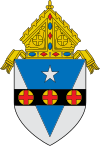| Type | Catholic |
|---|---|
| Founded | December 7, 1895 |
| Ceased publication | July 2012 |
| City | Philadelphia |
| Country | United States |
The Catholic Standard & Times, published from 1895 to 2012,[1] was the official newspaper of the Roman Catholic Archdiocese of Philadelphia.
It was the product of the merger of two earlier Catholic newspapers of Philadelphia.[2] The Catholic Standard, the official organ of the Diocese of Philadelphia, was published by Wm. Pepper & Co.[3] from January 6, 1866, to November 30, 1895. The Catholic Times ran from December 3, 1892, to November 23, 1895.[4]
The Catholic Standard & Times published its first issue on December 7, 1895.[4] Until its last few years, it published 50 times per year, except the week of July 4 and the last week of the year. It won numerous press awards from the Philadelphia Press Association and the Catholic Press Association and was a member of the latter.[5]
The newspaper received no funding from the archdiocese; revenues came from advertising and parish and home subscriptions.[1] In 2007, declining revenue led the paper to begin to cut costs.[1] In 2011, it moved to a monthly schedule.[6] It was discontinued in July 2012.
Although the physical newspaper is no longer in publication, the website CatholicPhilly.com remains active and is the official news website of the archdiocese.
YouTube Encyclopedic
-
1/3Views:2 3631 2187 328
-
The Catholic Processional Cross and the Roman Standard
-
The Roman Catholic Church and the Symbol of Iron In Bible Prophecy
-
The Wilderness Tabernacle, Herodian Temple and the Roman Catholic Mass
Transcription
During the entrance procession, incense is carried before an acolyte who holds a long staff that bears the quintessential Christian symbol —the cross. Despite being part of the liturgy since at least the 6th century, the custom of processing while holding aloft ceremonial objects predates Christianity. Several cultures like the Egyptians, Babylonians and Greeks had processions where ritual items were carried before priests, governors and other persons of import. But arguably the most direct influence on the development of the Christian processional cross can be found in the practices of ancient Rome— particularly in it's use of a distinctive military object— the standard For several hundred years, the Roman Empire encompassed much of the known world, and her conquests were a product of the Army's efficiency, loyalty and ferocity. One of the most striking visual aspects of the Imperial Army were tall poles affixed with various insignia and symbols called "standards." Each century, cohort and legion had its own symbols that were often associated with the birthday of the unit or its founder, while other emblems commemorated military exploits or other victories. In this way, standards helped preserve the cohesiveness and pride of the soldiers, as it embodied the unit's milestones and achievements. Standards served important war-time functions. Army units required a device to watch and follow in battle and soldiers needed to recognize their own units at a glance in order not to be scattered. The tall standards were see above the fighting, and waving them in a predetermined manner relayed troop movements and provided other instructions. As the Empire grew, standards also helped unite the many soldiers who were recruited from foreign lands. The standards reminded them that, before they were Britons, Gauls or Balkans, they were, above all, a soldier for Rome. Off the field of battle, standards took part in several civic and religious celebrations where they were anointed with oils and carried in processions. Roman standards were held in awe, o much so that Tertullian, writing in the second century, declared that soldiers worshiped their standards above all gods. Historians speculate that when Christianity was legalized began to codify its liturgy in the fourth century, Roman standards served as inspiration for the development of the processional cross. John Chrysostom, Archbishop of Constantinople, and St. Augustine, Archbishop of Canterbury were among the first to introduce its use. Saint Bede in his work "The Ecclesiastical History of the English People" describes St. Augustine as carrying a Silver Cross for a standard. For ancient Rome, standards were seen as a distinguishing mark for its military units. Simply put, the Roman armies carried standards to show who they were. For us, the cross is the mark of OUR identity as Christians. It marks us as those claimed by Christ. It is the quintessential symbol that unites the faithful much more so than a national flag or coat of arms ever could. Before originating from one nation or another; before hailing from this family or that; even before being male or female, above all else, Christians belong to Christ and they follow his cross. It is befitting, then, that this tenet manifest itself literally by having a cross carried in procession. It is the mark that overshadows all others and it is the cross that leads the faithful in worship.
See also
- John Patrick Foley (former editor)
References
- ^ a b c "About Us – Catholic Philly". catholicphilly.com. Retrieved 2022-04-30.
- ^ "The Catholic Standard and Times (Philadelphia, Pa.) 1895-Current". Library of Congress, Washington, D.C. 20540 USA. Retrieved 2022-04-30.
- ^ "Catholic Standard (Philadelphia [Pa.]) 1866-1895". Library of Congress, Washington, D.C. 20540 USA. Retrieved 2022-04-30.
- ^ a b "Catholic Newspapers in Philadelphia". Catholic Historical Research Center of the Archdiocese of Philadelphia. Retrieved 2022-04-30.
- ^ cst-phl.com "who we are" accessed 2010/6/19
- ^ "Catholic Standard And Times Newspaper Will Only Print Monthly". 2011-03-30. Retrieved 2022-04-30.
External links

